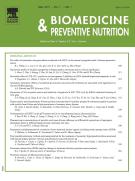Red azaphilone pigments extracted from red yeast rice induces cellular senescence and reduces viability in HepG2 cells - 07/12/13
Abstract |
Red yeast rice (Monascus fermented rice) contains monacolin K (MK), an HMG-CoA reductase inhibitor. Red yeast rice (RYR) contains a variety of other potential biological active molecules. The objective of this study was to study the effects of a crude extract and a fraction that contained the red azaphilione pigments rubropunctamine and monascorubramine and compare this to pure monacolin K (MK) in a hepatocarcinoma cell line (HepG2). An MTT proliferation assay showed that RYR crude, MK, and fraction 4 (red pigments) reduced cell growth in a dose-dependent manner with 72h LC50 values of 0.734±0.015mg/mL for RYR crude, 8.842±1.703μg/mL for MK and 0.039±0.002mg/mL for fraction 4. Cell death was determined using three distinct flow cytometry assays for apoptosis (sub-G1 cell cycle analysis, TUNEL apoptosis assay and multi-caspase apoptosis assay). The TUNEL apoptosis assay after 72h of treatment showed a larger apoptotic cell accumulation after MK treatment (22.45±0.60%) and RYR crude extract (18.22±0.62%) compared to fraction 4 (7.29±0.09%). After 72h treatment, fraction 4 induced cellular senescence in a dose dependent manner. Cell had morphological changes and increase in β-galactosidase activity, a marker of senescence and causes irreversible growth arrest. This is the first report describing cellular senescence of red monascus pigments extract isolated from RYR.
Le texte complet de cet article est disponible en PDF.Keywords : Red yeast rice, Anzaphilone pigments, Cellular senescence
Plan
Vol 3 - N° 4
P. 331-337 - octobre 2013 Retour au numéroBienvenue sur EM-consulte, la référence des professionnels de santé.
L’accès au texte intégral de cet article nécessite un abonnement.
Déjà abonné à cette revue ?


